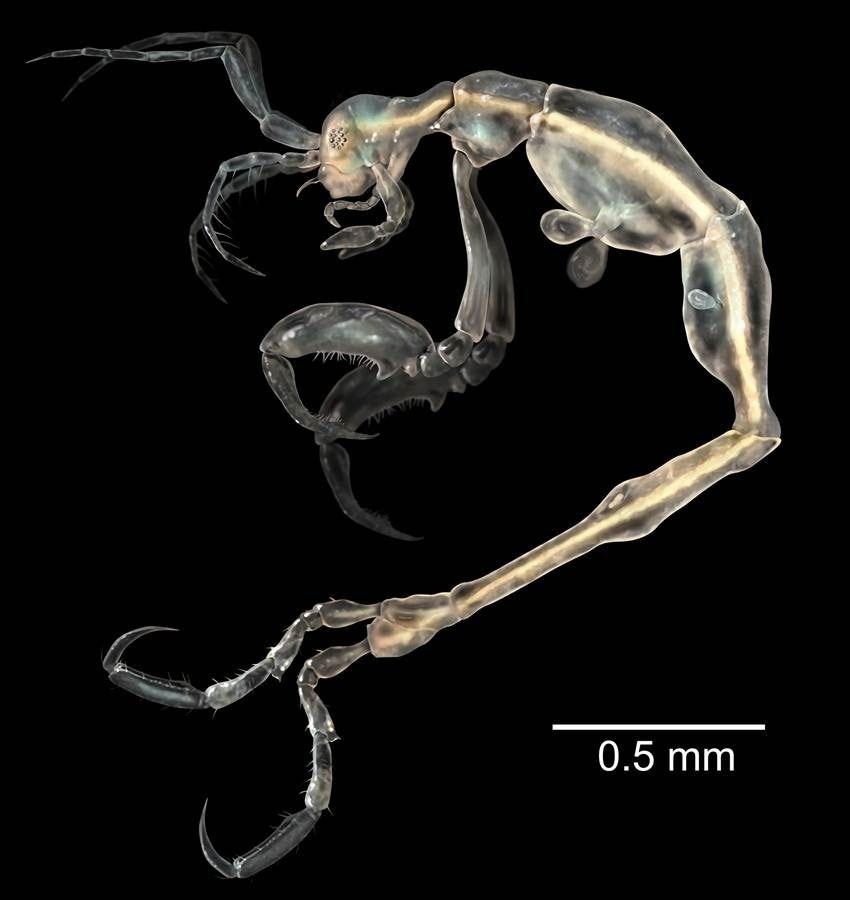Welcome to the Halloween edition of the Species Hall of Fame. In 2014, a newly discovered species of skeleton shrimp became famous… well, as famous as a small, slender, stick-like skeleton shrimp, that isn’t really a shrimp, can be. With translucent bodies, it took little imagination to compare these amphipods to skeletons. It was selected as one of the Top Ten New Species of the preceding year and subsequently featured in popular media outlets as diverse as Scientific American and NBC News.
Liropus minisculus, male. CREDIT: SINC (SERVICIO DE INFORMACION Y NOTICIAS CIENTÌFICAS) AND J.M. GUERRA-GARCÍA. SOURCE: SUNY-ESF TOP 10 NEW SPECIES 2014.
Liropus minisculus is among the predatory skeleton shrimp. It was found in a reef cave in California waters, off the coast of Catalina Island. When a new species is first collected, it is not always obvious that it is new. In fact, it is a common occurrence for specimens of new species to sit in museum collections for years or even decades before an expert with the appropriate knowledge comes along and recognizes that it is new. In this case, one male and one female had been deposited in the Canadian Museum of Nature and sat there until Jose Manuel Guerra-Garcia from the University of Seville and museum staff member Ed Hendrycks recognized its significance as a species new to science, the first record for the genus in the northeastern Pacific, and the smallest of all known species in the genus with the male a tad over 3mm and the female about a millimeter shorter
The nearly 10,000 known species of amphipods represent perhaps one third of the total number. Amphipods are crustaceans lacking a carapace and usually with laterally compressed bodies. They vary in size from less than 1 mm to more than a foot and are for the most part detritivores or scavengers. Inhabitants of almost every aquatic habitat, there are more marine than freshwater species by far. And let’s not forget sandhoppers found out of the water on beaches.
Skeleton shrimp belong to the amphipod family Caprellidae. They occur from intertidal zones to the deep sea, most often in shallow waters where they are found clinging with hind legs to substrates such as algae, seagrass, hydroids and bryozoans. They have been compared to praying mantis, with their large, fearsome-looking claws and the habit of sitting motionless until an unsuspecting food item passes within reach. Some species are filter feeders, others, like Liropus minisculus capture prey. Caprellid diets include diatoms, detritus, protists, and small invertebrates. They are not always particular about the substrate they hold on to, showing up on ropes, fish cages, nets, buoys, and even oil platforms, sometimes in large numbers.
The lives of skeleton shrimp are as weird as their eerie appearance. Males are usually significantly larger than females, although all caprellids are small. Antennae are used by some species for filter feeding. And when skeleton shrimp walk, it is in inchworm fashion, grasping the substrate alternately with front then back legs. They are not very good swimmers, there movement through the water involving an awkward bending, then straightening, of the body.
Skeleton shrimp are variously predators, detritovores, or micro-herbivores. Some species are geographically widespread and sometimes locally abundant, while others are considered threatened. Mating takes place when the female exoskeleton is between new and fully hardened. Females have a brood pouch in which they retain eggs and from which young emerge in juvenile adult form. In keeping with the mantis comparison, and our Halloween theme, females of some species ungratefully kill the male after mating by injecting him with venom from the claw on her gnathopod.
Bad deeds do not always go unpunished. Skeleton shrimp are themselves eaten by real shrimp, nudibranchs, anemones, and jellyfish. While not a major food for fish in general, shiner perch migrate to eelgrass beds where they target caprellids and they are also eaten by a variety of other fishes including Chinook salmon, yellow tail, and sea horses.
Some skeleton shrimp lead even more unusual lives in association with other species. Caprella bathytatos, described in 1998, attaches itself to the mouthparts of spider crabs found around deep-sea hydrothermal vents more than 2000 meters beneath the surface.
If you would like to see some video of living caprellids, I highly recommend the episode of Ze Frank’s “True Facts” about skeleton shrimp, available on YouTube. It is a delightful collision of facts, visuals, and irreverent humor. Ze Frank’s account of skeleton shrimp is like a cross between David Attenborough and Harry Vanderspeigle. If you aren’t familiar with Dr. Vanderspeigle, pop some corn, do yourself a favor, and binge watch the first two seasons of Resident Alien. You’ll thank me. And, if you don’t know David Attenborough, well, you may be beyond help.
Happy Halloween from the Species Hall of Fame!
Further Reading
Guerra-Garcia, Jose M. and Ed A. Hendrycks (2013) A new species of Liropus (Crustacea, Amphipoda, Caprellidae) from California, USA, with an illustrated key of the genus. Zootaxa 3718: 467-476.
International Institute for Species Exploration (2014) Top 10 New Species. SUNY ESF.
Martin, J. W. and G. Pettit (1998) Caoprella bathytatos new species (Crustacea, Amphipoda, Caprellidae) from the mouthparts of the crab Macroregonia macrochira Sakai (Brachyura, Majidae) in the vicinity of deep-sea hydrothermal vents off British Columbia. Bulletin of Marine Science 63: 189-198.




